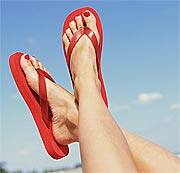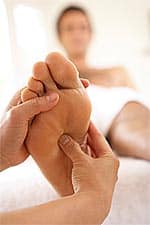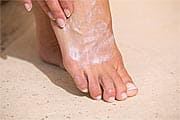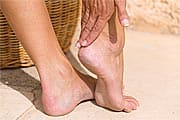Life Extension Magazine®
Our feet support tremendous daily pressure and weight, making them susceptible to injury, fatigue, microorganisms, and infections that can spread throughout the body. Unfortunately, few of us provide proper preventive care for our hardworking feet. In order to maintain healthy feet one must focus on a variety of goals that include muscle and pain relief, protection against bacterial and fungal infections as well as optimal hydration. As we get older, the feet tend to lose their protective fat, which, together with free-radical damage from photoaging, can cause the once soft and smooth skin to become wrinkled, leathery, and to lose its natural elasticity. These factors not only deteriorate the appearance of the feet—they can erode our overall health and vitality.
Doctors are now discovering that targeted natural agents such as essential oils and botanical extracts can help energize and protect our depleted feet. The results are healthier feet with a more youthful appearance that are shielded against infectious invaders. A feat of natural structural engineering, your feet serve as both a shock absorber and propulsion engine that are capable of withstanding incredible stresses.1 Not surprisingly, to support this daily pressure, they contain over 25% of all the body’s bones and have the thickest skin of all your body parts. Yet despite their natural padding and cushioning layer of fat, they are also extremely sensitive since the soles of the feet contain more pressure-sensitive nerve endings than any other part of the body. These tactile nerve endings also occupy more room in the sensory cortex of the brain than the entire torso.
Taking Care of Your Feet“When our feet hurt, we hurt all over.”—Socrates
Unfortunately, many commercial foot creams and lotions are composed mainly of water. As this water enters the skin, it temporarily expands the tissues much like air filling a balloon, so wrinkles fade away and your skin feels smoother. As soon as the water evaporates or gets carried away by the bloodstream, however, the dryness and wrinkles always return. In addition, these products often contain highly refined vegetable oils that have been stripped of all their natural protective antioxidants. As a result, they are highly prone to free-radical oxidation that can actually make your skin age faster. In effect, although these creams and lotions may bring about temporary improvement, they could actually end up accelerating a vicious cycle of skin aging. Fortunately, a number of natural substances, including certain essential oils and herbal essences have been scientifically proven to overcome these problems and help your feet look younger and feel healthier. Soothing Power of EucalyptusOne of nature’s most powerful ingredients for moisturizing, soothing, and detoxifying hard-working feet is eucalyptus oil. Its ability to modulate ceramides (lipid component of skin structure) helps the skin’s outer layer to retain moisture. This is extremely important for the feet, which can excrete as much as one pint of moisture every day. A compound called 1,8-cineole in eucalyptus facilitates the production of hydrating ceramides in the epidermal cells,2 increasing the skin’s softness and suppleness. Carefully extracted by steam distillation from the leaves and stems of the tallest and fastest growing tree in the world, eucalyptus essential oil contains about 80% 1,8-cineole (its main active ingredient) and other healthy plant essences such as pinene and limonene.3 Not only does eucalyptus oil enhance the water-binding ability of ceramides, it has long been used in therapeutic programs to help cleanse and detoxify the skin. Eucalyptus oil also has potent antibacterial, antifungal, and antimicrobial properties4 against a wide range of microorganisms that prosper in moist, dark environments.
Aromatherapy experts have long believed that quality essential oils like eucalyptus oil can also penetrate deeply into the skin and enhance circulation, thus promoting the delivery of oxygen and essential nutrients to the skin’s deepest layers. Tired feet therefore benefit from the natural soothing properties of eucalyptus, a proven analgesic5 that is one of the best oils known for lessening the discomfort associated with joint and muscle aches. These numerous benefits of eucalyptus oil make it an essential ingredient in a program designed to hydrate, soothe, and protect the feet. Refresh Tired Feet with MentholUsed medicinally in Japan for over 2,000 years but not isolated in the West until approximately 200 years ago, menthol constitutes about 50% of the essential oil in peppermint.
When massaged into the skin, menthol has a miraculous effect on the sensory nerves by stimulating those that produce a cool, soothing sensation to refresh tired, aching feet.6 Menthol does this by activating what scientists call transient receptor potential ion channels. These channels function as receptors for natural compounds such as menthol that evoke thermal sensations across the entire peripheral nervous system.7 Furthermore, menthol inhibits a specific pain receptor,8 a finding that may help explain its effectiveness as a topical analgesic for the relief of minor skin discomforts. In addition to its local cooling and pain-relieving properties, menthol can speed up healing by dilating blood vessels,9 so increasing blood flow to the affected area, which is an important property in alleviating muscle and joint soreness. Still another therapeutic property of menthol is its ability to help subdue many types of pathogenic fungi and bacteria10 and so prevent them from establishing infection in the moist, dark areas between the toes. All of these features make this versatile ingredient a must-have ingredient in the ultimate formula for healthier, happier feet.
Antioxidant Tea BlendAnother ingredient that can protect the delicate skin of the feet is antioxidant-rich tea extract.
The skin is highly susceptible to the damaging effects of free radicals—marauding molecules that rob electrons from the millions of cells in the body, including the skin’s vital connective tissues. The connective fibers of the skin give it strength and elasticity, but they gradually begin to break down with aging as a result of continual free-radical bombardment. The damaged connective tissues of the skin’s supporting framework become hardened and lose their ability to hold together. The once young, soft, and smooth skin of the feet then begins to sag and wrinkle, turning dry and leathery and displaying signs of premature aging. Fortunately, potent extracts of red, green, and white tea can penetrate deep into the skin to protect it from oxidative stress and inflammation that threaten its youthful appearance and function.11-13 Red tea is an especially powerful source of antioxidants,11 while green tea provides the protection of epigallocatechin-3-gallate (EGCG), a potent phytochemical that guards skin against the ravages of UV exposure and DNA damage.14 Scientists believe that the vitamin C activity of tea extracts may contribute to healthy skin tone and structure by supporting the formation of new collagen.15-17 Topical tea extracts thus provide antioxidant protection for optimal foot care by quenching damaging free radicals, counteracting the normal effects of aging, and keeping connective tissues strong and supple. Nourish and Hydrate With SqualeneAnother natural substance that has the power to soothe and heal your feet is squalene. Squalene is a biochemical precursor in the body’s synthesis of cholesterol. It is also one of the principal hydrocarbons contained in the protective surface lipids of the skin, where it amounts to approximately 15% of the total fat content, although this declines substantially with aging.18 Distributed widely throughout most of nature, squalene is found in everything from the liver of deep sea sharks to vegetable sources like olive, palm, wheat germ, and rice bran oils. Truly one of nature’s great emollients, squalene is quickly and efficiently absorbed deep into the skin, restoring healthy suppleness and flexibility without leaving an oily residue. This highly effective natural moisturizer is great at replenishing missing oils and soothing dry, rough, or sun-exposed skin. It’s no wonder that countless generations of fishermen from Scandinavia, Japan, and the South Pacific have used fish oils rich in squalene for healing the irritated skin of their faces and hands. Squalene from olive oil is generally preferred for dermatological use, however, because of its greater stability. Olive oil contains about 0.2-0.7% squalene.19 In addition to its ability to naturally nourish and hydrate tissue, evidence suggests that squalene may help fight dangerous bacteria that can infect the skin.20 Squalene also has potent antioxidant effects that may benefit skin health. Experimental evidence indicates that squalene is a highly effective oxygen-scavenging agent.21 Squalene’s molecular composition allows it to donate electrons in order to neutralize dangerous peroxide radicals. Squalene has a chemical structure that is similar to vitamin A, allowing it to protect the skin surface from lipid peroxidation due to UV exposure and other sources of oxidative stress. Squalene’s powerful free radical-quenching ability has been shown to be equal to that of butylated hydroxytoluene or BHT, one of the most powerful antioxidants known to science.21 Squalene not only inhibits the growth of disease-causing microorganisms, but also moisturizes, heals, and nourishes the skin of your feet, leaving them looking younger and feeling silky soft and smooth.
Antimicrobial Benefits of Coconut OilEarly Spanish explorers called this large, round, hairy nut with the three indentations (that looked oddly like two eyes and a nose) “coco,” meaning “monkey face.” The coconut palm itself is so highly prized among the Pacific Islanders as a source of food, shelter, and medicine that they simply call it “The Tree of Life.” Polynesians have long used coconut oil cosmetically as an ointment to help maintain their smooth and soft skin, mixing it with different varieties of flowers and other seed oils such as ylang ylang, kukui, and sandalwood for added fragrance and variety. Also a staple of traditional medicine among Asian and Pacific Island populations for thousands of years, the oil of the coconut has been used for diverse health concerns ranging from mosquito bites to indigestion. It is only recently, however, that medical science has begun to unlock the incredible healing powers of coconut oil. Coconut oil is one of nature’s richest sources of medium chain triglycerides. These novel lipids are almost identical to the medium chain fatty acids found in human sebum and have demonstrated interesting health benefits.22 Coconut oil and its constituents have been credited with antibacterial, antiviral, and antifungal properties,23,24 which may help to prevent skin infections. In fact, a derivative of coconut oil has demonstrated broad-spectrum activity against numerous types of bacteria implicated in superficial skin infections.25 Coconut oil has also shown antifungal benefits against Candida albicans, a type of yeast involved in vaginal yeast infections as well as thrush (a fungal infection affecting the oral cavity).24 The combination of your sweat along with coconut oil fatty acids creates a thin, protective mantle on the skin that helps keep pathogens at bay. Coconut oil also softens and moisturizes while removing dirt from the outer layer of skin, leaving it shiny and smooth. In consideration of all these wide-ranging benefits, it’s only fitting that coconut oil takes its rightful place as one of the key ingredients in optimal foot care. Shea Butter For Smoother, Softer SkinAnother topical ingredient widely hailed for its skin-health benefits is shea butter. Derived from the fruit of an African tree, shea butter is an ivory-colored fat that acts as a rich topical moisturizer and emollient. Shea butter is a rich source of vitamin E,26 a powerful antioxidant that is a popular ingredient in anti-aging skin formulations. Topically applied vitamin E is widely used to fight wrinkles, fade excess pigmentation, protect against UV light-induced damage, and preserve the skin’s protective barrier functions.27-29 While scientists are still investigating the many possible applications of shea butter, fans of this rich moisturizer credit it with fading scars, relieving eczema, soothing severely chapped skin and lips, lightening skin discolorations, and fading wrinkles and stretch marks. When applied to the feet, shea butter produces an immediate skin-softening effect. ConclusionYour feet deserve the best of care especially during later life when the risks of infection, photoaging, dehydration, and everyday aches and pain are greatest. Wash them regularly and use a good foot cream containing natural, health-promoting ingredients. Protective essential oils and botanical extracts such as eucalyptus oil, menthol, tea antioxidants, squalene, coconut oil, and shea butter provide powerful ingredients to help rejuvenate the feet. By locking in moisture, combating microbial infections and free radical-induced damage, and relieving everyday aches and pains, these bioactive agents can help feet look and feel younger. As a result, they will also feel happier and healthier—and so will you. If you have any questions on the scientific content of this article, please call a Life Extension Health Advisor at 1-800-226-2370. | ||||||||||||
| References | ||||||||||||
| 1. Available at: http://www.aapsm.org/running.html. Accessed June 20, 2008. 2. Anjos JL, Neto DS, Alonso A. Effects of 1,8-cineole on the dynamics of lipids and proteins of stratum corneum. Int J Pharm. 2007 Dec 10;345(1-2):81-7. 3. Saify ZS, Ahsan O, Dayo A. Cineole as skin penetration enhancer. Pak J Pharm Sci. 2000 Jan;13(1):29-32. 4. Ashour HM. Antibacterial, antifungal, and anticancer activities of volatile oils and extracts from stems, leaves, and flowers of Eucalyptus sideroxylon and Eucalyptus torquata. Cancer Biol Ther. 2007 Dec 2;7(3). 5. Silva J, Abebe W, Sousa SM, et al. Analgesic and anti-inflammatory effects of essential oils of Eucalyptus. J Ethnopharmacol. 2003 Dec;89(2-3):277-83. 6. Tsuzuki K, Xing H, Ling J, Gu JG. Menthol-induced Ca2+ release from presynaptic Ca2+ stores potentiates sensory synaptic transmission. J Neurosci. 2004 Jan 21;24(3):762-71. 7. Bautista DM, Siemens J, Glazer JM, et al. The menthol receptor TRPM8 is the principal detector of environmental cold. Nature. 2007 Jul 12;448(7150):204-8. 8. Macpherson LJ, Hwang SW, Miyamoto T, et al. More than cool: promiscuous relationships of menthol and other sensory compounds. Mol Cell Neurosci. 2006 Aug;32(4):335-43. 9. Futami T. Actions and mechanisms of counterirritants on the muscular circulation. Nippon Yakurigaku Zasshi. 1984 Mar;83(3):219-26. 10. Pattnaik S, Subramanyam VR, Bapaji M, Kole CR. Antibacterial and antifungal activity of aromatic constituents of essential oils. Microbios. 1997;89(358):39-46. 11. McKay DL, Blumberg JB. A review of the bioactivity of South African herbal teas: rooibos (Aspalathus linearis) and honeybush (Cyclopia intermedia). Phytother Res. 2007 Jan;21(1):1-16. 12. Ojo OO, Ladeji O, Nadro MS. Studies of the antioxidative effects of green and black tea (Camellia sinensis) extracts in rats. J Med Food. 2007 Jun;10(2):345-9. 13. Gawlik M, Czajka A. The effect of green, black and white tea on the level of alpha and gamma tocopherols in free radical-induced oxidative damage of human red blood cells. Acta Pol Pharm. 2007 Mar;64(2):159-64. 14. Katiyar SK. Skin photoprotection by green tea: antioxidant and immunomodulatory effects. Curr Drug Targets Immune Endocr Metabol Disord. 2003 Sep;3(3):234-42. 15. du TR, Volsteedt Y, Apostolides Z. Comparison of the antioxidant content of fruits, vegetables and teas measured as vitamin C equivalents. Toxicology. 2001 Sep 14;166(1-2):63-9. 16. Wha KS, Lee IW, Cho HJ, et al. Fibroblasts and ascorbate regulate epidermalization in reconstructed human epidermis. J Dermatol Sci. 2002 Dec;30(3):215-23. 17. Bell E, Rosenberg M, Kemp P, et al. Recipes for reconstituting skin. J Biomech Eng. 1991 May;113(2):113-9. 18. Passi S, De PO, Puddu P, Littarru GP. Lipophilic antioxidants in human sebum and aging. Free Radic Res. 2002 Apr;36(4):471-7. 19. Smith TJ. Squalene: potential chemopreventive agent. Expert Opin Investig Drugs. 2000 Aug;9(8):1841-8. 20. Wille JJ, Kydonieus A. Palmitoleic acid isomer (C16:1delta6) in human skin sebum is effective against gram-positive bacteria. Skin Pharmacol Appl Skin Physiol. 2003 May;16(3):176-87. 21. Kohno Y, Egawa Y, Itoh S, et al. Kinetic study of quenching reaction of singlet oxygen and scavenging reaction of free radical by squalene in n-butanol. Biochim Biophys Acta. 1995 Apr 28;1256(1):52-6. 22. Amarasiri WA, Dissanayake AS. Coconut fats. Ceylon Med J. 2006 Jun;51(2):47-51. 23. Kirszberg C, Esquenazi D, Alviano CS, Rumjanek VM. The effect of a catechin-rich extract of Cocos nucifera on lymphocytes proliferation. Phytother Res. 2003 Nov;17(9):1054-8. 24. Ogbolu DO, Oni AA, Daini OA, Oloko AP. In vitro antimicrobial properties of coconut oil on Candida species in Ibadan, Nigeria.J Med Food. 2007 Jun;10(2):384-7. 25. Carpo BG, Verallo-Rowell VM, Kabara J. Novel antibacterial activity of monolaurin compared with conventional antibiotics against organisms from skin infections: an in vitro study. J Drugs Dermatol. 2007 Oct;6(10):991-8. 26. Maranz S, Wiesman Z. Influence of climate on the tocopherol content of shea butter. J Agric Food Chem. 2004 May 19;52(10):2934-7. 27. Rona C, Vailati F, Berardesca E. The cosmetic treatment of wrinkles. J Cosmet Dermatol. 2004 Jan;3(1):26-34. 28. Burke KE. Interaction of vitamins C and E as better cosmeceuticals. Dermatol Ther. 2007 Sep;20(5):314-21. 29. Thiele JJ, Ekanayake-Mudiyanselage S. Vitamin E in human skin: organ-specific physiology and considerations for its use in dermatology. Mol Aspects Med. 2007 Oct;28(5-6):646-67. 30. Available at: http://www.water.org.uk/home/water-for-health/medical-facts/skin. Accessed June 20, 2008. |






